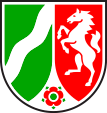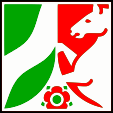zur deutschen Version, Flagge klicken oder tippen

- North Rhine-Westphalia (Nordrhein-Westfalen, NRW)
- formed in 1946
- since 1949 federal country of the FRG
• Flags
• Meaning/Origin of the Flag
• Coat of Arms
• Meaning/Origin of the Coat of Arms
• Map
• Numbers and Facts
• History

Flag of the country,
ratio = 3:5,
Source, by: Flags of the World




Official flag,
ratio = 3:5,
Source, by: Flags of the World






The flag and the coat of arms of North Rhine-Westphalia were introduced in 1948 and confirmed in 1953. In her assembly of the colours is the flag a combination of the colours of the prussian provinces Rhineland (green-white) and Westfalia (white-red). The coat of arms shows the heraldic symbols for the country-parts Rhineland (white wave-line on green ground), Westfalia (white horse on red ground) and Lippe-Detmold (red rose on white ground). In the twenties of the 20th century Rhinanian separatists already used the same flag (without the coat of arms!).
Source:
Die Welt der Flaggen,
Volker Preuß,
Beflaggungsregelungen für Nordrhein-Westfalen


Coat of arms of North Rhine-Westphalia,
Source, by: Corel Draw 4

since 2007,
stylized coat of arms,
Source, by: www.land.nrw

since 2009,
North Rhine-Westphalia Sign,
Source, by: www.land.nrw

The coat of arms of North Rhine-Westphalia was introduced in 1948 and confirmed in 1953. The coat of arms shows the heraldic symbols for the country-parts Rhineland (white wave-line on green ground), Westfalia (white horse on red ground) and Lippe-Detmold (red rose on white ground). The white horse in the coat of arms is the "Westfalia Horse". It has its roots as "Saxons Ross" in the Tribal-Duchy of Saxony and was later adoped from the Welfen-Dynasty. Their symbol was actually a golden lion on red ground. In this way became it the heraldic animal of the Kingdom of Hannover (since 1866 Prussian Province of Hannover), of the Prussian Province of Westfalia and since 1922 of the Country of Brunswick. This tradition is continued in the FRG at those federal countries to which formerly Welfian territories belong. In this way they have until today the white horse in their coats of arms: Lower Saxony and North Rhine-Westphalia.
Source:
Die Welt der Flaggen,
Volker Preuß
"The coat of arms of the state of North Rhine-Westphalia shows the Rhine River, Ross and Rose and is coloured in green, white and red. In addition to the national coat of arms, there is also a so-called North Rhine-Westphalia Sign. Unlike the official coat of arms, this can be used by anyone." ¹
Source: ¹ www.land.nrw

FRG and its countries, clickable map:

Source: Freeware, University of Texas Libraries, modyfied by: Volker Preuß

Area: 13.161 square miles
Inhabitants: 17.849.000 (2012)
Density of Population: 1.356 inh./sq.mi.
Capital: Düsseldorf, 592.000 inh.
Source: Wikipedia (D)

The country North Rhine-Westphalia was formed on 1st of August in 1947 by order of the allied from the Prussian Province of Westfalia, the northern part of the Prussian Rhine Province and the country Lippe-Detmold.
Source:
Wikipedia (D)







Kindly supported by: A. Kortmann (D)
![]()










